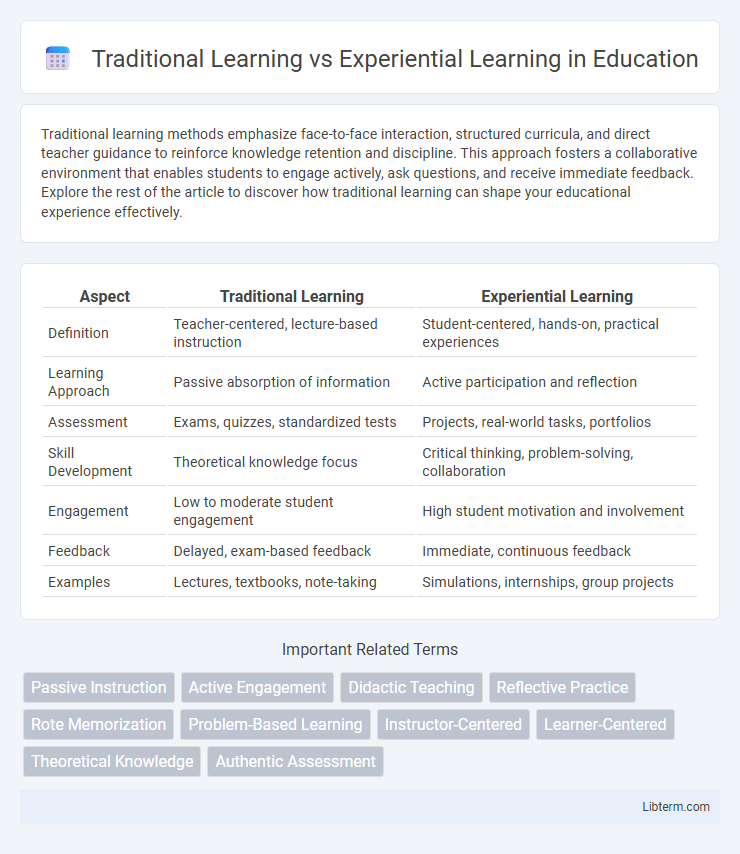Traditional learning methods emphasize face-to-face interaction, structured curricula, and direct teacher guidance to reinforce knowledge retention and discipline. This approach fosters a collaborative environment that enables students to engage actively, ask questions, and receive immediate feedback. Explore the rest of the article to discover how traditional learning can shape your educational experience effectively.
Table of Comparison
| Aspect | Traditional Learning | Experiential Learning |
|---|---|---|
| Definition | Teacher-centered, lecture-based instruction | Student-centered, hands-on, practical experiences |
| Learning Approach | Passive absorption of information | Active participation and reflection |
| Assessment | Exams, quizzes, standardized tests | Projects, real-world tasks, portfolios |
| Skill Development | Theoretical knowledge focus | Critical thinking, problem-solving, collaboration |
| Engagement | Low to moderate student engagement | High student motivation and involvement |
| Feedback | Delayed, exam-based feedback | Immediate, continuous feedback |
| Examples | Lectures, textbooks, note-taking | Simulations, internships, group projects |
Introduction to Learning Paradigms
Traditional learning emphasizes structured, teacher-centered instruction with a fixed curriculum, focusing on memorization and theoretical knowledge acquisition. Experiential learning prioritizes hands-on experiences, reflection, and active engagement, enabling learners to apply concepts in real-world contexts. Understanding these learning paradigms highlights the shift from passive reception to active participation in education methodologies.
Defining Traditional Learning
Traditional learning centers on structured classroom environments where knowledge is delivered through lectures, textbooks, and standardized assessments. This method emphasizes memorization, repetition, and instructor-led activities, focusing on theoretical understanding. Core features include a fixed curriculum, teacher authority, and passive student participation.
Understanding Experiential Learning
Experiential learning emphasizes hands-on, real-world experience as a core method for acquiring knowledge, contrasting traditional learning's reliance on lectures and textbooks. This approach engages learners actively through projects, simulations, and practical tasks, enhancing retention and critical thinking skills. Understanding experiential learning involves recognizing its cycles of action, reflection, and application, which foster deeper comprehension and skill mastery.
Key Differences Between Traditional and Experiential Learning
Traditional learning emphasizes passive absorption of information through lectures and textbooks, prioritizing memorization and standardized testing. Experiential learning centers on active participation, encouraging learners to engage in real-world tasks and reflect on their experiences for deeper understanding. This approach fosters critical thinking, problem-solving skills, and retention by linking theory with practical application.
Advantages of Traditional Learning Methods
Traditional learning methods offer structured curriculum and standardized assessments, ensuring consistent knowledge delivery and measurable academic progress. Classroom settings provide direct interaction with experienced instructors, enabling immediate feedback and clarification. This approach fosters discipline, routine, and foundational skill development essential for advanced educational pursuits.
Benefits of Experiential Learning Approaches
Experiential learning approaches enhance knowledge retention by engaging learners in hands-on activities that simulate real-world experiences, fostering critical thinking and problem-solving skills. This method promotes deeper understanding through active participation, encouraging collaboration and adaptability in dynamic environments. Practitioners of experiential learning often demonstrate improved motivation and confidence, translating theoretical concepts into practical application efficiently.
Challenges Faced by Traditional Learning
Traditional learning often faces challenges such as limited student engagement and passive knowledge absorption, which hinder critical thinking development. The reliance on rote memorization and standardized testing restricts creativity and real-world application of skills. Additionally, traditional methods may fail to address diverse learning styles, resulting in lower retention and motivation among students.
Limitations of Experiential Learning
Experiential learning often faces limitations such as the variability of real-world scenarios, which can lead to inconsistent knowledge acquisition compared to structured traditional learning methods. It may also demand significant resources, including time, facilitators, and materials, making it less scalable in large educational settings. Furthermore, the subjective nature of experiences can result in unequal learning outcomes, as individual reflection and interpretation heavily influence knowledge retention.
Impact on Student Engagement and Retention
Traditional learning often relies on passive information delivery, which can limit student engagement and reduce long-term retention of knowledge. Experiential learning methods, such as hands-on activities and real-world problem-solving, significantly boost student involvement by fostering active participation. Research indicates that experiential learning enhances retention rates by up to 70%, as it connects theoretical concepts with practical application, making learning more meaningful and memorable.
Choosing the Right Approach for Modern Education
Traditional learning emphasizes structured curricula, lecture-based instruction, and assessment through exams to build foundational knowledge. Experiential learning prioritizes hands-on activities, real-world problem-solving, and reflective practices, fostering critical thinking and practical skills. Selecting the right approach depends on educational goals, student engagement, and the need to equip learners with adaptable competencies for future challenges.
Traditional Learning Infographic

 libterm.com
libterm.com